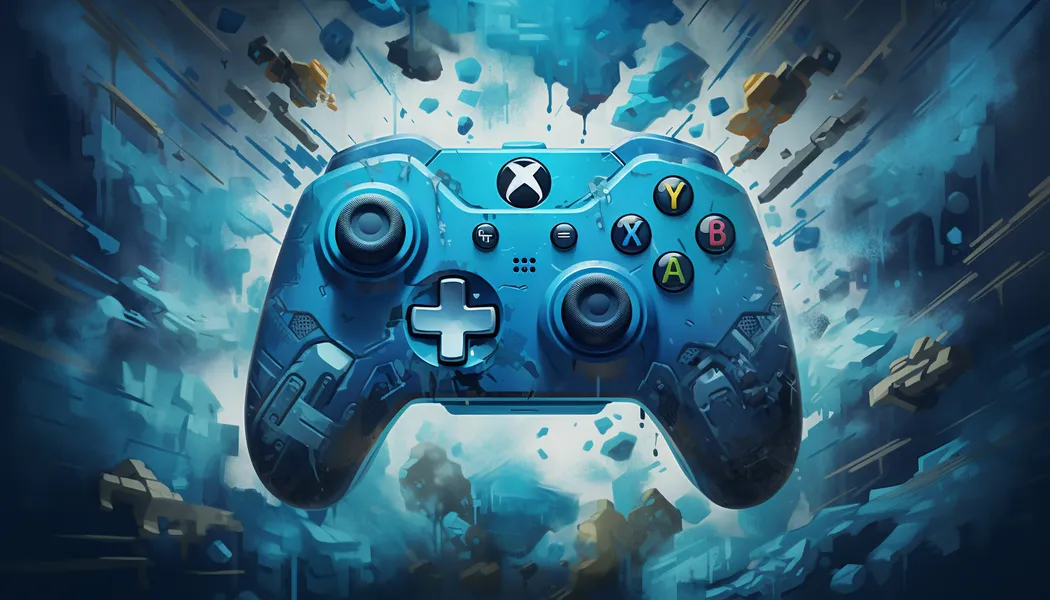
Integrating Steam Input with Godot 4
Integrating Steam Input with Godot's Input system.
This article a work in progress. It’s being published early to allow users of the GodotSteam discord to use it as a reference.
Setting up
This article assumes you’ve already:
Given that you’ve already those steps, we’re going to begin by adding our own initialization code to our Steam autoload.
The SteamControllerInput.init() function needs to be called after Steam.initInput() and Steam.enableDeviceCallbacks().
Steam.inputInit()Steam.enableDeviceCallbacks()SteamControllerInput.init()Creating our SteamControllerInput script
First let’s create a new script called steam_controller_input.gd and add it to our autoloads under the name SteamControllerInput.
Next, let’s get some prep work done and define some variables to store our handles and the actions we’re going to be querying Steam Input for.
extends Node## A globally accessible manager for device-specific actions using SteamInput for any controller## and standard Godot Input for the keyboard.#### All methods in this class that have a "device" parameter can accept -1## which means the keyboard device.
# The actions defined in the Steam .vdf file are listed here# with true or false indicating if input is analog or digital.# False is digital (buttons), true is analog (joysticks, triggers, etc).var action_names := { "Move": true, "Up": false, "Down": false, "Left": false, "Right": false, "Jump": false, "Pause": false,}
# Track if we've gotten the handles yet.var got_handles := false
# The action set handles and the current action set.var game_action_setvar current_action_set
# Store the resulting handles for each action.var actions = {}Handling Connections
Here we’re creating the init function that gets called in our Steam autoload, and connecting to the Steam.input_device_connected and Steam.input_device_disconnected signals to handle when a player connects or disconnects their controller.
## Call this after calling `Steam.inputInit()` and `Steam.enableDeviceCallbacks()`func init() -> void: Steam.input_device_connected.connect(_on_steam_input_device_connected) Steam.input_device_disconnected.connect(_on_steam_input_device_disconnected)
func _on_steam_input_device_connected(input_handle: int) -> void: if not got_handles: get_handles() Steam.activateActionSet(input_handle, current_action_set) print("Device connected %s" % str(input_handle))
func _on_steam_input_device_disconnected(input_handle: int) -> void: print("Device disconnected %s" % str(input_handle))Getting Action Handles
You need to wait until a controller has been connected before you can get the action and action set handles.
If you try to get them before a controller has been connected GodotSteam will return 0 for all handles.
Though, as I was writing this I’m still encountering handles returning 0 even after a controller has been connected,
so this feels like a bug, similar to the controllers not responding if you pause your game via get_tree().paused = true.
Hopefully these will both be addressed soon.
Now that a controller is connected, we can get the action set and action handles.
In this example .vdf file I have a single action set called GameControls and a number of actions defined within it.
func get_handles() -> void: got_handles = true game_action_set = Steam.getActionSetHandle("GameControls") current_action_set = game_action_set get_action_handles(action_names)Now we iterate over the action names and get the handles for each action, using the Steam.getAnalogActionHandle and Steam.getDigitalActionHandle functions depending on the input type.
func get_action_handles(action_names: Dictionary) -> void: for action in action_names.keys(): # If true, analog if action_names[action]: actions[action] = Steam.getAnalogActionHandle(action) else: actions[action] = Steam.getDigitalActionHandle(action)What about keyboards?
Steam Input doesn’t handle keyboard input, so for my use case I’m not going to be able to use Steam Input directly in gameplay code.
As long as we name the action the same in Godot’s Input system as we do in Steam Input, we can write a simple wrapper to check both easily.
Get Connected Controllers
Since we’ll be supporting both Steam Input and a keyboard via GodotInput,
we can specify -1 as the device ID for the keyboard, and add any detected controllers to the list of device IDs.
func get_controllers() -> Array[int]: var controllers: Array[int] = [-1] var steam_controllers = Steam.getConnectedControllers() if steam_controllers: controllers.append_array(steam_controllers) return controllersBut now that we have controllers, how do we use them?
Input Wrappers
These wrappers expect a device handle to be passed in. If the device handle is less than 0, it will fall back to the default Input functions, so I use -1 to indicate a keyboard.
get_action_strength
Get the strength of an action. This is useful for analog inputs such as a single axis of a joystick, or a trigger.
Steam’s getAnalogActionData function returns a Vector2 with the x and y values of the action, but the y value is always 0 for single axis inputs such as triggers. By only returning the x value we can emulate Godot’s get_action_strength function.
func get_action_strength(device: int, action: StringName, exact_match: bool = false) -> float: if device >= 0: if not got_handles: return 0 # getAnalogActionData returns only the x axis for single axis inputs such as triggers. var action_data = Steam.getAnalogActionData(device, actions[action]) return action_data.x return Input.get_action_strength(action, exact_match)get_axis
get_axis is useful for things like left/right movement that is comprised of two actions, one for left and one for right.
func get_axis(device: int, negative_action: StringName, positive_action: StringName) -> float: if device >= 0: if not got_handles: return 0 # getAnalogActionData returns only the x axis for single axis inputs such as triggers. var negative = Steam.getAnalogActionData(device, actions[negative_action]) var positive = Steam.getAnalogActionData(device, actions[positive_action]) return positive.x - negative.x return Input.get_axis(negative_action, positive_action)get_vector
get_vector is largely used for movement, and is useful for things like joysticks or dpads.
We need to invert the y axis because Steam’s y axis is inverted from Godot, but otherwise emulates Godot’s get_vector function.
## This is equivalent to Input.get_vector except it will only check the relevant device.func get_vector(device: int, negative_x: StringName, positive_x: StringName, negative_y: StringName, positive_y: StringName, deadzone: float = -1.0) -> Vector2: if device >= 0: if not got_handles: return Vector2.ZERO var negative_x_val = Steam.getAnalogActionData(device, actions[negative_x]) var positive_x_val = Steam.getAnalogActionData(device, actions[positive_x]) var negative_y_val = Steam.getAnalogActionData(device, actions[negative_y]) var positive_y_val = Steam.getAnalogActionData(device, actions[positive_y]) # Steam's y axis is inverted compared to Godot return Vector2(positive_x_val - negative_x_val, -(positive_y_val - negative_y_val)).normalized() return Input.get_vector(negative_x, positive_x, negative_y, positive_y, deadzone)get_move_input
In order to use an analog joystick from Steam Input, we define a name for the input in the Steam In-Game Actions File.
In this example, I’ve named it “Move”. In Godot I’m querying the Left/Right and Up/Down actions, but they could be named whatever you define yourself.
This is one of the few functions that don’t share the same name action names between Steam Input and Godot Input.
func get_move_input(device: int) -> Vector2: if device >= 0: if not got_handles: return Vector2.ZERO # Get the analog stick movement var action_data = Steam.getAnalogActionData(device, actions["Move"]) return Vector2(action_data.x, -action_data.y).normalized() return Vector2(Input.get_axis("Left", "Right"), Input.get_axis("Up", "Down")).normalized()Tracking press/release states
By default, Godot gives a really nice set of Input functions that allow you to check if an action was just pressed or just released this frame. This can be very useful for ensuring that you only perform an action once per press, or for tracking how long an action has been held for.
Unfortunately, Steam Input doesn’t give us that functionality, so we need to implement it ourselves.
Let’s start by adding a new dictionary to store the state of each action at the top of our file:
# Store the resulting handles for each action.var actions := {}
# Store the state of each action and the frame it entered that state.var action_states := {}Getting the action state
In order to use that dictionary, we’ll need a function to get the action state for a given device and action.
If the action state doesn’t exist yet, we’ll create it with the default values, setting held to false and press_frame and release_frame to -1.
func get_action_state(device: int, action: String) -> Dictionary: # Get the current action, but create the defaults along the way if they don't exist. if not action_states.get(device): action_states[device] = {} if not action_states[device].get(action): action_states[device][action] = { "held": false, "press_frame": -1, "release_frame": -1 } return action_states[device][action]Though that won’t be useful without a way to set the action state!
Setting the action state
In order to set the action state, we’ll need to know the current state of the action, and the current frame. We can then compare the current state to the previous state to determine if the action was just pressed or just released.
By tracking the frame that the action was pressed or released we can easily implement our missing input methods!
func set_action_state(device: int, action: StringName, currently_held: bool, current_frame: int) -> Dictionary: # Get the state of the action last frame var previous_action_state = get_action_state(device, action)
# If we're pressing the action now and we weren't pressing it last frame, # track that we pressed the action this frame. if currently_held and not previous_action_state.held: action_states[device][action].held = true action_states[device][action].press_frame = current_frame # If we're not pressing it this frame but we were pressing it last frame, # track that we released the action this frame. elif not currently_held and previous_action_state.held: action_states[device][action].held = false action_states[device][action].release_frame = current_frame
# Return the current state of the action return action_states[device][action]is_action_pressed
To check if the action was just pressed we can use the Steam.getDigitalActionData function to check if the action is currently held.
But, if we stop there we will have failed to track the press frame, so we’ll need to call our set_action_state function to update the state of the action.
func is_action_pressed(device: int, action: StringName, exact_match: bool = false) -> bool: if device >= 0: if not got_handles: return false var current_frame = Engine.get_process_frames() var currently_held = Steam.getDigitalActionData(device, actions[action]).state set_action_state(device, action, currently_held, current_frame) return currently_held # If keyboard, use normal Godot input system. return Input.is_action_pressed(action, exact_match)is_action_just_pressed
Checking if the action was just pressed is very similar to checking if it’s pressed, but we also ensure the press_frame is the current frame.
func is_action_just_pressed(device: int, action: StringName, exact_match: bool = false) -> bool: if device >= 0: if not got_handles: return false var current_frame = Engine.get_process_frames() var currently_held = Steam.getDigitalActionData(device, actions[action]).state var action_state = set_action_state(device, action, currently_held, current_frame) return currently_held and action_state.press_frame == current_frame # If keyboard, use normal Godot input system. return Input.is_action_just_pressed(action, exact_match)is_action_just_released
In order to check if the action was just released, we need to check if the action is not currently held, and if the release frame is the current frame.
func is_action_just_released(device: int, action: StringName, exact_match: bool = false) -> bool: if device >= 0: if not got_handles: return false var current_frame = Engine.get_process_frames() var currently_held = Steam.getDigitalActionData(device, actions[action]).state var action_state = set_action_state(device, action, currently_held, current_frame) return not currently_held and action_state.release_frame == current_frame # If keyboard, use normal Godot input system. return Input.is_action_just_released(action, exact_match)Questions?
And that’s most of what I’m doing so far.
Every frame my player script uses the input script to check if the player should move, jump, etc.
movement_input = SteamControllerInput.get_move_input(deviceId)jump_input_actuation = SteamControllerInput.is_action_just_pressed(deviceId, "Jump")jump_input = SteamControllerInput.is_action_pressed(deviceId, "Jump")I’ve got plans to put more detail in a few areas but let me know if something is unclear or you’re trying to do something I haven’t covered here. I’m in the GodotSteam discord as furd, feel free to talk to me there.
I’ve got a few things still in the works but by assigning a deviceId to your player you can use this to check the input for a specific player.
Enjoy!
